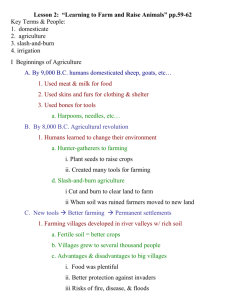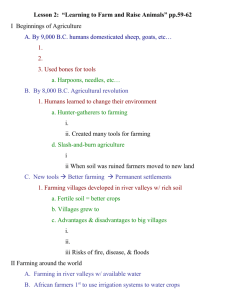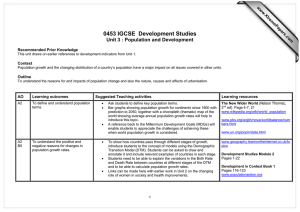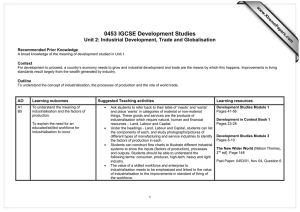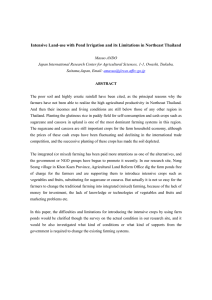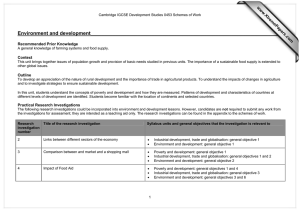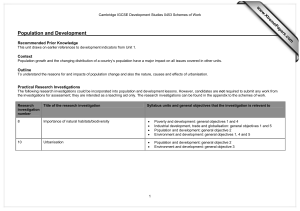0453 IGCSE Development Studies Unit 4: Environment and Development www.XtremePapers.com
advertisement
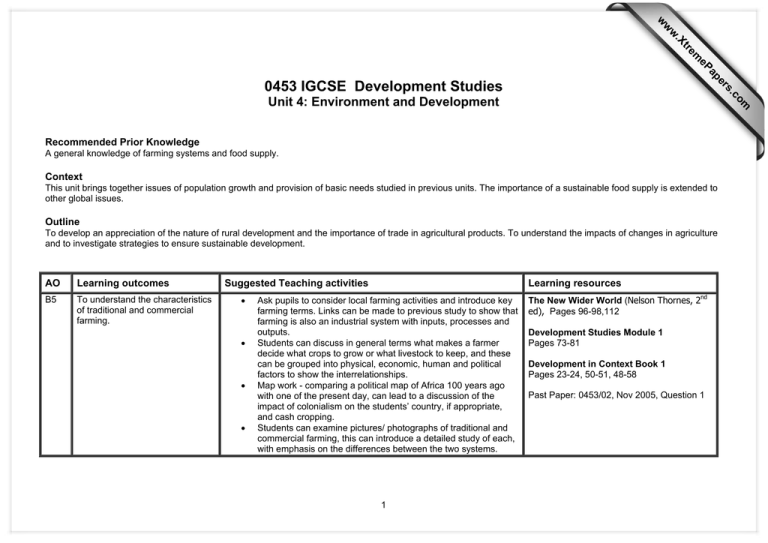
s er ap eP m e tr .X w w w om .c 0453 IGCSE Development Studies Unit 4: Environment and Development Recommended Prior Knowledge A general knowledge of farming systems and food supply. Context This unit brings together issues of population growth and provision of basic needs studied in previous units. The importance of a sustainable food supply is extended to other global issues. Outline To develop an appreciation of the nature of rural development and the importance of trade in agricultural products. To understand the impacts of changes in agriculture and to investigate strategies to ensure sustainable development. AO Learning outcomes B5 To understand the characteristics of traditional and commercial farming. Suggested Teaching activities • • • • Learning resources Ask pupils to consider local farming activities and introduce key farming terms. Links can be made to previous study to show that farming is also an industrial system with inputs, processes and outputs. Students can discuss in general terms what makes a farmer decide what crops to grow or what livestock to keep, and these can be grouped into physical, economic, human and political factors to show the interrelationships. Map work - comparing a political map of Africa 100 years ago with one of the present day, can lead to a discussion of the impact of colonialism on the students’ country, if appropriate, and cash cropping. Students can examine pictures/ photographs of traditional and commercial farming, this can introduce a detailed study of each, with emphasis on the differences between the two systems. 1 The New Wider World (Nelson Thornes, 2nd ed), Pages 96-98,112 Development Studies Module 1 Pages 73-81 Development in Context Book 1 Pages 23-24, 50-51, 48-58 Past Paper: 0453/02, Nov 2005, Question 1 AO A1 C10 Learning outcomes To evaluate rural development schemes and strategies. Suggested Teaching activities • • Case studies may be appropriate here. The change from growing staple foods to growing cash crops in terms of its impact on local food supply and health and also the natural environment can be discussed. • Reference can be made here to Unit 5 where solutions to urbanisation concerning improvements to rural areas were suggested. Selected rural development schemes can be considered such as credit schemes, land reform, agricultural extension services and diversification etc. A case study of a co-operative would be valuable to highlight its benefits. The vicious circle of poverty introduced in Unit 1 can be returned to here with reasons as to why it is hard to break, but how different strategies help to disrupt the downward spiral of poverty can be shown on the diagram. For example, a tarred road means access to market which means income for the farmers so they can pay for education and buy better food, which leads to improved health. Integrated rural development schemes that address large numbers of problems can be studied with examples of bottom up (grass roots) and top down decision making. Draw up a class list of all the factors students consider are essential to reduce rural poverty and lead to development of rural areas. Students then rank these in order of priority and compare results. Role Play/Decision making exercise: students divide into groups. One represents the officials from the Rural Development Agency who have to decide on which projects to spend money. Other groups put the case for the different measures. Development in Context Book 1 Pages 59-70 Interpretation of world maps showing incidence of child malnutrition and world population growth forecasts will make the need to increase food output apparent to students. The New Wider World Pages 110-113 • • • • • A3 To appreciate the ways food output can be increased and why this is important. Learning resources • 2 Development Studies Module 1 Pages 82-95 Past Paper: 0453/01, Nov 2004, Question 1 Past Paper: 0453/01, Nov 2007, Question 6 AO Learning outcomes Suggested Teaching activities • • • • A1 To recognise the growth and importance of a world market for agricultural products. • • • A2 To understand the causes and impacts of land degradation. • • Learning resources More traditional methods of increasing food supply such as animal breeding, irrigation and fertilisers can be considered together with the Green Revolution, particularly in terms of its successes and failures. Photographs of crop growing using hydroponics can illustrate a high technology method. Class Debate: GM crops are the best way to reduce hunger in the world. The topical issue of biofuels may be mentioned here in terms of reducing the land available for growing food crops and causing a rise in prices of basic food commodities. Development Studies Module 1 Pages 90-91 http://en.wikipedia.org/wiki/Hydroponics Students can be asked to consider the local problems of storage, preservation and transport to a local market, of crops from the surrounding farmland. This idea can then be extended to world trade after a consideration of the main producers and main consumers of primary commodities. The need to process foodstuffs to increase their value as exports and their importance as foreign currency earners to many low income countries’ development needs to be stressed with reference back to balance of trade studied in Unit 3. The problem of monopolies controlling prices, the changing demand for food from the NICs and the growth of Fairtrade products can all be discussed. The New Wider World Pages186-189 As an example of a fragile environment, the case study of desertification in the Sahel would be a good introduction to this topic as it covers overpopulation, overgrazing, soil erosion low rainfall etc. A photograph of eutrophication of a water course could be used to illustrate the environmental impacts of commercial farming in terms of overuse of artificial nitrate fertilisers The impact of pesticides and other aspects of commercial farming on wildlife Development Studies Module 1 Pages 96-100 3 www.foodfuture.org.uk www.guardian.co.uk/environment/2007/aug/2 9/food.g2 The New Wider World Pages 108-109,117, 254-258 www.edenfoundation.org/project/desertif.html AO Learning outcomes Suggested Teaching activities Learning resources and the environment could be illustrated either by drawing a labelled sketch of the landscape or by annotating a suitable photograph or picture. Methods of prevention or reduction of land degradation can be portrayed in a similar way. A3 C10 To consider the sustainability of modern farming systems. • • • • • • Discuss with students the idea that contemporary solutions to the problem of the gap between food supplies and world population growth need to be sustainable. Revise the meaning of the term sustainable. Decision making exercise: Should a farmer convert his system to an organic one? Students can consider this in terms of an analysis, with economic and environmental benefits in one column and disadvantages in another. How this system has the potential to reverse soil degradation can be emphasised. The sustainability of modern farming systems can then be considered in table form - with subsistence, plantations, fairtrade systems, hydroponics, organic, GM crops etc along the top and all issues of sustainable development down the side. If the farming type satisfies the issue, it can be ticked, given a mark on a scale of 1-5 or Not Applicable. The issues that need to be considered include: livestock welfare, wildlife and habitat protection, use of pesticides, control of pollution of water courses from nitrate fertilisers, conservation of water supplies and soil, use of local resources, recycling of materials (including manure), use of renewable energy resources as well as issues concerned directly with income to improve standard of living such as employment and use of appropriate technology. Reference can be made here to the MDGs, particularly 1 and 7. 4 www.orgprints.org/5161 www.new-agri.co.uk/07/03/develop/dev5.php http://www.isis.org.uk/FAOPromotesOrganicAgriculture.p hp AO Learning outcomes A1 A4 To assess the impact of deforestation on a local and global scale, To suggest ways to conserve forests and to understand why this is so important. Suggested Teaching activities • • • C8 To examine pressure on other resources resulting from urbanisation and industrialisation To consider conservation methods to limit exploitation of the environment. • • • Learning resources This topic could be introduced by working out how many hectares of tropical rainforests have disappeared from the planet already to give an idea of the scale of the problem. Loss of biodiversity can be explained so that students are aware that it is not just trees that are being destroyed. Ask students what the small and large scale causes of the destruction may be. Local effects can be illustrated on a diagram showing a forested and cleared hillside either side of a stream. Global effects may be considered here but may alternatively be dealt with later. The various conservation methods including reafforestation, designated areas, more sustainable logging methods etc. can be considered with reference to those used in the students’ country. Role Play: Groups representing illegal loggers, wildlife conservationists, foresters, local tribesmen, loggers with licences, government officials, factory owner etc. all put their case for or against clearing a large area of primary forest. Revise with students the scale of population growth and urbanisation in some countries and the importance of industrialisation to a country’s development. They can then consider the increased demand for minerals, water and power in particular and the impact on the environment of meeting these increased needs. The potential for using sustainable power resources in the students’ own country can be researched. Ask students to draw a spider diagram with the word ‘waste’ in the centre. Leading from this, students to write down the various sources of waste from homes and industry, they can then be asked to think up solutions to this. This can lead on to a list of causes of water pollution with effects on human health and food chains in the rivers being explained. The entertainment and tourist industry can be studied from a 5 The New Wider World Pages 236-243 Development Studies Module 1 Pages 98-103 www.oxfam.org.uk/coolplanet/ontheline/explo re/nature/rainforest/deforest.htm www.mongabay.com/brazil.html www.fao.org/newsroom/ then search under deforestation Past Paper: 0453/02, Nov 07, Question 2 The New Wider World Pages 122-125, 290 Past Paper: 0453/01, Nov 05, Question 1 Past Paper: 0453/01, Nov 06, Question 2 www.energysavingtrust.org.uk/generate_your _own_energy/how_renewable_energy_works www.voicesforburma.org/responsibletourism/negative-influences-of-tourism AO Learning outcomes Suggested Teaching activities Learning resources local perspective in terms of its growth, benefits, demands on resources, impacts on the environment etc. C8 C9 To understand the causes and impacts of air pollution and to assess the possible strategies to reduce its effects. • • • • • • • Ask students to draw some manufacturing industries with chimneys and label the different emissions that cause global warming, ozone depletion and acid rain. The local and global effects of ozone depletion and acid rain can be listed under the different headings. The causes of global warming are best shown on a diagram and the impacts labelled on a world map in the correct locations. A discussion of the strategies governments and individuals might adopt to reduce carbon dioxide emissions must include a consideration of the importance of preventing large scale destruction of forests. Research Exercise: Students plan research into how their school and students can contribute to reducing their impact on climate change. This will involve researching secondary data to gain background information to the topic. Different equipment using power in the school can be counted with an estimate of the hours used per week. Questionnaires can be devised to find out how people travel to school, forms of recycling used (paper, plastic etc), source of food (home-grown, local market, shop) etc. Students will have other suggestions. Once data has been gathered, students can be asked to come up with solutions. On a scale of 1-5 (disagree strongly – agree strongly) people can be asked questions such as ‘global warming is a massive problem for the world’,’ it is up to high income countries to sort out the problem they have created’, ‘individuals can do little, it is up to governments’ etc. Students need to appreciate the value of a pilot study and then consider the advantages and disadvantages of different sampling techniques. An interview with the Headteacher to assess his/her views on 6 The New Wider World Pages 218-221 Development in Context Book 2 Page 117 Development Studies Module 4 Pages 73-90 www.foe.co.uk/campaigns/climate/issues/cli mate_change/ www.climatechallenge.gov.uk/ http://en.wikipedia.org/wiki/Ozone_depletion http://en.wikipedia.org/wiki/Acid_rain AO Learning outcomes Suggested Teaching activities • A1 B7 C8 To assess the impact on development of a natural disaster and To evaluate the ways the government and NGOs dealt with the effects. • • • • Learning resources the school setting up recycling bins, etc. would contribute further information. A variety of data presentation methods can be used before an analysis of the findings is made and conclusions drawn. An evaluation of the project can suggest problems that were encountered and improvements that could have been made. A case study that is either current or one that has affected the students’ own country would be appropriate. A brief outline of the cause of the disaster and its location could be followed by a list of human and environmental effects. Decision making exercise: Students consider the different approaches to deal with the aftermath of the disaster and draw conclusions as to their relative success or failure. They may be able to suggest better solutions to the problems encountered. The effects of certain natural disasters can be reduced by forward planning and how best to undertake this could be considered for the particular case study chosen. The impact on development will depend on the scale of the natural disaster chosen and the amount of aid forthcoming as well as the existing state of development of the country concerned. Ask students to briefly research several other disasters to show how the scale of suffering varies. 7 The New Wider World Pages 268-269, 272273 www.redcross.org.uk www.oxfam.org.uk/Oxfam_in_action/emerge ncies/index.html www.guardian.co.uk/naturaldisasters Other newspapers have sites that will include reports of current emergencies.


